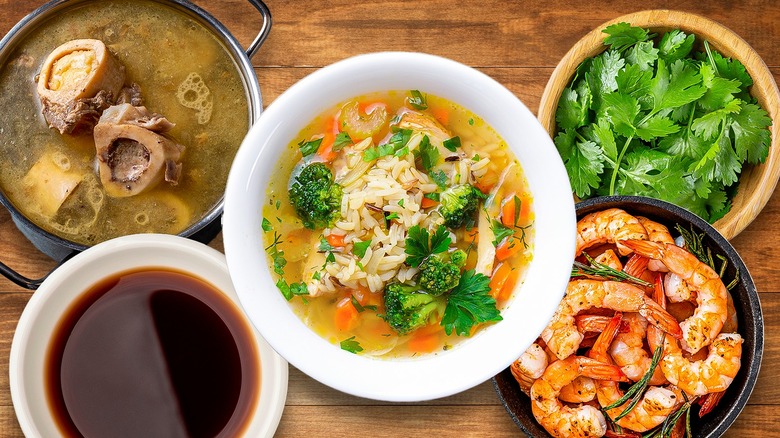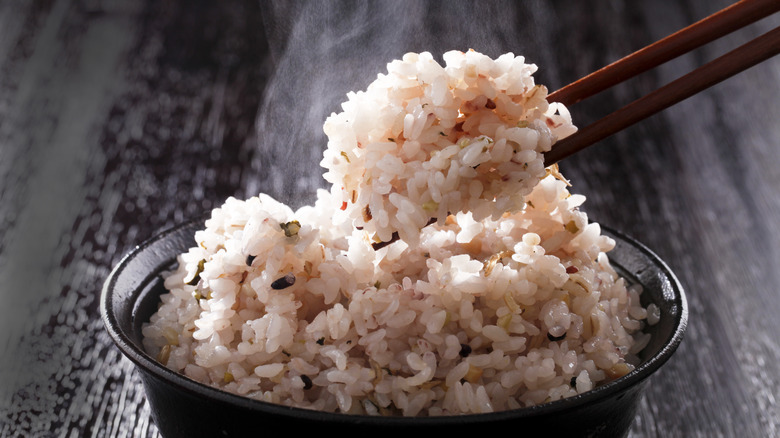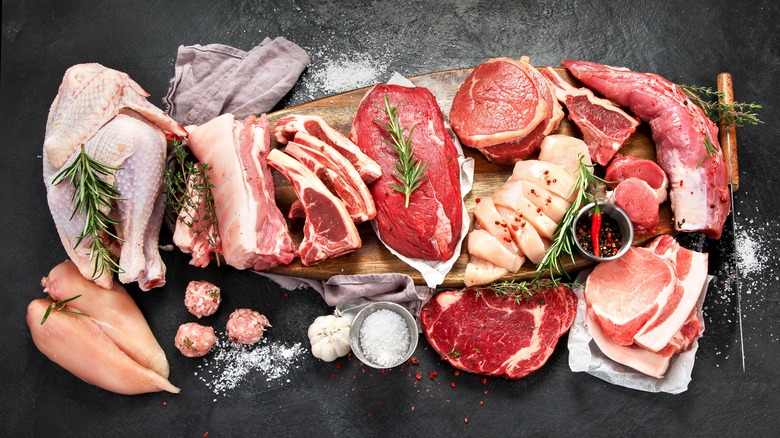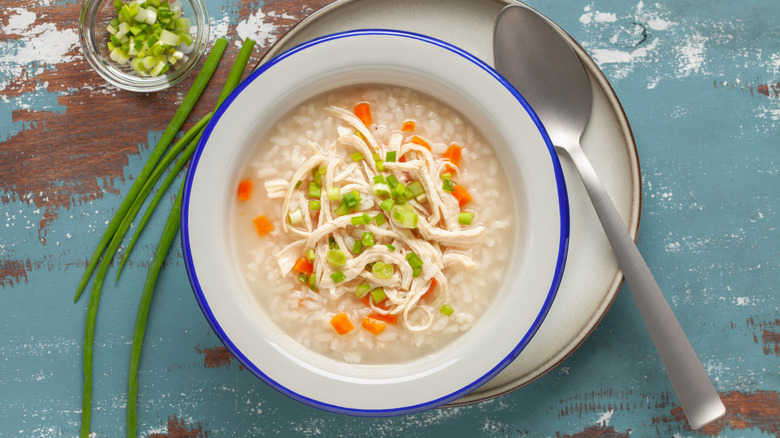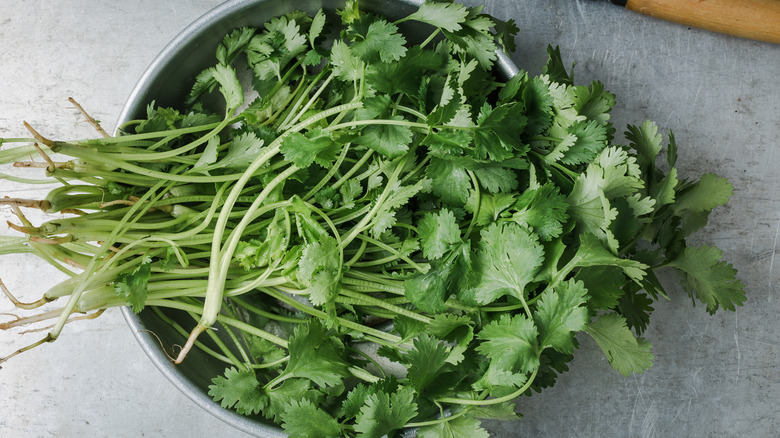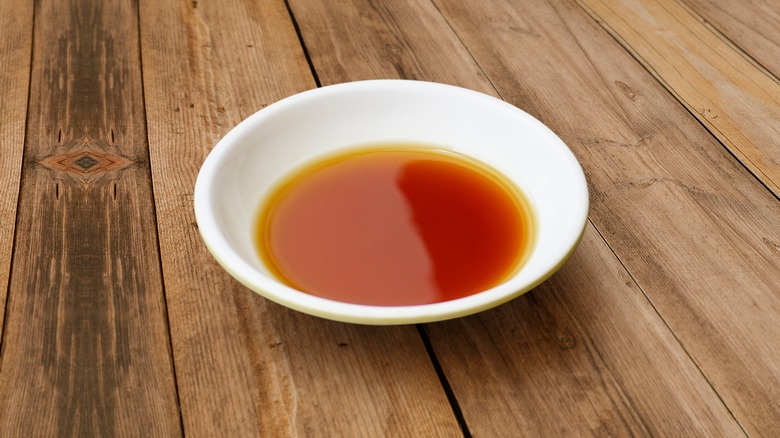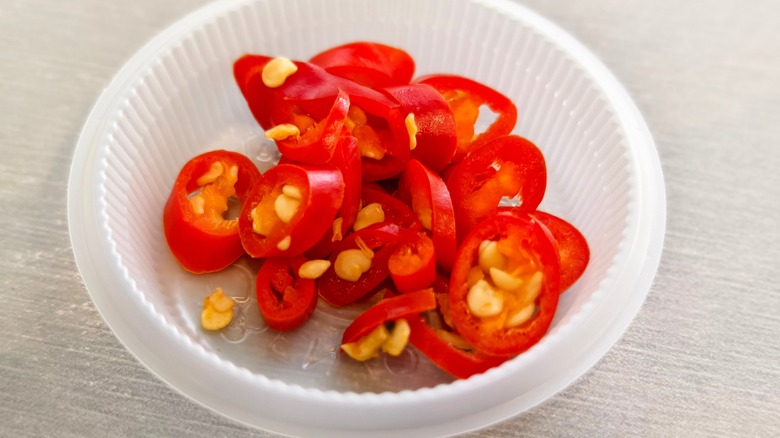11 Tips For Restaurant-Worthy Sizzling Rice Soup
Sizzling rice soup is the ultimate comfort-meets-showstopper dish. It's that satisfying moment when crisped rice meets a savory broth, crackling and releasing a rush of steam that smells like pure magic. More than a soup, this dish is a sensory experience. Mastering a recipe like sizzling rice soup at home brings an extra layer of pride, and with just a few chef-approved tweaks, you'll be on your way to creating restaurant-worthy magic right from your own kitchen.
As a professional cook, I've seen firsthand how little details transform a dish, and sizzling rice soup is all about contrasts. The crispy rice brings texture; the broth brings a deep, warming flavor. The beauty lies in the balance, from choosing a rice that crisps to golden perfection to timing fresh, tender vegetables and savory proteins just right. The goal is to build a soup that feels layered and bold, with each element bringing something memorable to the bowl.
In this guide, I'll walk you through creating each component with restaurant-level finesse. We'll dive into tricks for making that irresistible crispy rice, techniques for a good broth, and tips for adding proteins and vegetables that keep the dish fresh and vibrant. With a few mindful steps, you'll have a sizzling rice soup that's equal parts cozy and impressive, ready to wow guests or bring a touch of culinary theater to a weeknight.
Choosing the right rice
Choosing the right rice is crucial for getting that signature crispy crunch that defines sizzling rice soup. Not all rice varieties can achieve the golden, crisp exterior we're after. For the best results, stick with long-grain rice like jasmine or basmati. Long-grain rice varieties have lower moisture levels and a slightly firmer texture, allowing them to fry up beautifully without becoming too dense or chewy. Their structure holds up well, creating a satisfying crunch that adds texture and flavor to the soup.
Avoid short-grain rice varieties, which tend to be starchier and sticky — qualities that work well in sushi or risotto but fall short here. The goal is to create a crisp rice cake that doesn't soak up too much broth too quickly, so each bite remains crispy for just the right amount of time. With long-grain rice, you're building a foundation that brings the sizzle, enhancing the entire soup with that extra bit of drama and flavor.
By choosing a rice that crisps up light and golden, you're setting the stage for a sizzling rice soup that tastes refined, delicious, and deeply satisfying — just like the restaurant version but with your own touch.
Making crispy rice cakes
The crunch of sizzling rice is what makes this soup unforgettable, and the best way to achieve that perfect bite is by preparing crispy rice cakes. Start with day-old rice — fresh rice holds too much moisture, making it difficult to fry properly. Once cooled, press the rice firmly onto a baking sheet, forming a thin, even layer about 1/4 inch thick. For the ideal texture, let it dry overnight; this extra step allows the rice to lose enough moisture, making it easier to crisp up without becoming chewy.
To create those golden, crispy cakes, you can either fry or bake the rice. For frying, heat a generous amount of oil until it's hot enough to instantly sizzle. Add the rice in pieces, frying until golden brown. Baking works well, too — simply brush the pressed rice with oil and bake at high heat until it reaches that crispy, light-brown finish. Once cooked, break the rice into smaller pieces for easy spoonfuls that retain crunch in the broth.
Perfecting these crispy rice cakes takes a bit of patience, but the payoff is huge. Each piece should add texture and absorb just a bit of broth, providing the dramatic sizzle that's key to the dish. Done right, these rice cakes give sizzling rice soup its signature contrast — light and crispy on the outside, with just a hint of chewiness inside, creating that satisfying balance of textures in each bite.
Double fry for extra crispiness
For an unbeatable crunch in sizzling rice soup, consider double-frying the rice, a technique borrowed from dishes like Korean fried chicken known for its super-crispy exterior. Double-frying creates a light, shatteringly crispy texture that holds up in the hot broth, keeping each bite of rice satisfying and crunchy. The first fry sets the rice, giving it a golden, slightly crisp layer, while the second fry brings out that deep crunch that won't go soggy too quickly.
To double fry, begin by heating the oil and frying the rice pieces until they're just golden and lightly crisp. Allow them to cool, then hit them with a second fry until they reach a deeper golden brown with that perfect, crackling texture. This process is similar to Korean fried chicken, which uses the same method to create an ultra-crispy crust that stands out, even when sauced. For the rice, the double-fry technique ensures each piece stays light and crunchy as it absorbs the broth's flavor, enhancing the overall texture and making the soup an interactive experience with every spoonful. Double-frying gives you that restaurant-level quality, bringing sizzling rice soup to life with a satisfying, crispy bite in every spoonful.
Deep, rich broth
A deep, rich broth is the backbone of any great sizzling rice soup. For that restaurant-quality flavor, start with a deeply flavorful homemade stock using chicken or pork bones, simmered for hours with aromatics like ginger, garlic, and scallions. If you're adding shrimp to your soup, you might even peel the shrimp shells and use them in the stock, too. These ingredients infuse the broth with a fragrant warmth, creating a flavorful base that complements the crispy rice and fresh vegetables.
A slow simmer pulls out every bit of flavor, making your broth good and clear. For added depth, consider adding a dash of soy sauce or fish sauce, which brings a layer of savory umami without overwhelming the other flavors. And if you're looking for a slightly more complex flavor profile, toss in a couple of dried mushrooms — they lend a subtle earthiness that rounds out the broth beautifully.
This homemade broth isn't just a base; it's what brings harmony to the entire dish, tying together the crunch of the rice, the tenderness of the vegetables, and the savory notes of the proteins. A well-made broth elevates the soup to something special, making each spoonful as satisfying as it is flavorful.
Timing the vegetables
Vegetables play a big role in making sizzling rice soup feel fresh and layered, but timing their addition is key to keeping them crisp and vibrant. Add veggies like snow peas, mushrooms, and bok choy too early, and they lose that satisfying crunch. Instead, drop them into the soup right at the end, just minutes before serving. This quick-cook approach preserves their color, crunch, and natural sweetness, elevating the soup from comforting to truly restaurant-quality.
For best results, slice mushrooms thin, chop bok choy into bite-sized pieces, and leave snow peas whole. The unique textures each vegetable brings make every spoonful dynamic and well-balanced. Mushrooms contribute an earthy, umami flavor, while bok choy offers a slight bitterness that complements the heartiness of the broth. Snow peas add a pop of fresh sweetness, bringing out the subtle layers of the broth and balancing the savory elements.
Timing these veggies well not only enhances their individual flavors but also makes the overall experience more enjoyable, with every bite offering a blend of crispy rice, tender greens, and savory broth. It's all about creating a dish that keeps your palate engaged so that each spoonful feels fresh and satisfying, bringing a touch of restaurant finesse to a comforting classic.
Protein power
Using a variety of proteins is essential for making sizzling rice soup feel hearty and satisfying. Shrimp, chicken, and tofu each bring something unique to the soup, from the briny sweetness of shrimp to the savor of chicken and the delicate texture of tofu. Searing proteins first is key — it locks in flavor and creates a slightly caramelized exterior that elevates each bite, allowing the proteins to stand up to the rich broth without losing their character.
For shrimp, a quick sear brings out its natural sweetness and adds a hint of char that pairs beautifully with the broth's depth. Chicken, especially thigh meat, benefits from a similar treatment, becoming tender and flavorful. Tofu works best when lightly pan-fried for a slightly crispy exterior, giving it a satisfying texture that absorbs the broth's flavors without becoming too soft.
Including different proteins gives each spoonful a mix of textures and flavors, creating a well-rounded dish that feels substantial yet balanced. By treating each protein with a little extra care, you can create a bowl of sizzling rice soup that's vibrant, satisfying, and worthy of a restaurant menu.
Be patient
Good soup requires patience, and sizzling rice soup is no exception. To get that deep, layered flavor, give the broth enough time to simmer slowly and let each ingredient meld together. A quick boil won't do the trick here; letting the broth cook long and slowly extracts every bit of richness from the bones, aromatics, and seasonings. This extended cooking time allows flavors to deepen, creating a foundation that's both savory and complex, with the warm undertones of ginger, garlic, and any umami boosters you've added.
Cooking the soup low and slow also ensures that each element has time to release its unique character into the broth. The ginger becomes mellow and aromatic, the garlic softens and adds warmth, and if you're using ingredients like miso or fish sauce, they'll blend in seamlessly, enhancing the entire dish rather than standing out individually. Think of this step as building a flavor base.
As the broth cooks, an aroma will fill the kitchen — a telltale sign that everything's coming together. This patience pays off when you finally add the rice cakes, vegetables, and garnishes, as the flavors in the broth are now ready to complement and elevate each component. So resist the urge to rush; taking your time with the broth transforms sizzling rice soup from a simple bowl into a culinary experience. Embrace the process, and you'll be rewarded with a soup that's rich, nuanced, and worth every moment of simmering.
Achieving perfect texture
Sizzling rice soup stands out because of the contrasting textures that keep each bite interesting. A great bowl combines crispy rice that crackles at first and slowly softens, a rich, hot broth that draws out flavors, and vegetables that stay fresh and slightly crunchy. Timing is key to making these textures work together. The rice cakes should be dropped in just before serving to preserve their initial crunch — this delay keeps the texture dynamic, so they start crispy, then become chewy as they soak up the broth.
The thickness of the rice cakes also matters. If they're too thin, they'll turn mushy almost instantly; too thick, and they'll stay hard. Aim for pieces that are just thick enough to hold up for a few bites but thin enough to soften gradually, giving a nice depth to the soup. Vegetables, meanwhile, should be cooked to just tender, while proteins like shrimp or seared chicken bring a satisfying chew that complements the crispiness of the rice and the warmth of the broth. Each element brings something different to the bowl, creating a balance that elevates the soup from good to extraordinary.
Perfecting the interplay of these textures transforms sizzling rice soup into more than just comfort food; it becomes an engaging eating experience, where each spoonful brings something new. Mastering this harmony between crispy, tender, and chewy elements is the secret to achieving a memorable, restaurant-level, sizzling rice soup.
Garnishing with fresh herbs
Fresh herbs are the finishing touch that elevates sizzling rice soup from hearty to refined, adding both visual appeal and a final layer of flavor. Different herbs have different places in the rank and file of the kitchen, but for our soup, there are a few best practices. Right before serving, sprinkle in chopped green onions or a handful of fresh cilantro. Green onions bring a mild, peppery note that contrasts beautifully with the richness of the broth, while cilantro introduces a bright, citrusy flavor that enhances the soup's complexity. This garnish brings balance to each spoonful, keeping the soup feeling fresh and vibrant.
Beyond green onions and cilantro, feel free to experiment with other herbs. Thai basil can add an unexpected layer of sweetness and depth, while a touch of mint can bring a refreshing contrast, especially if the broth has a bold umami base. The vibrant green flecks from the herbs also bring color, making the dish visually stunning as well as delicious.
Using fresh herbs just before serving ensures they retain their aroma and texture, infusing the soup without wilting or losing their punch. The burst of herbal brightness rounds out the dish, making each spoonful feel balanced and multi-dimensional. With this last touch, your sizzling rice soup not only looks restaurant-ready but has that more complexity and depth that make it memorable.
Adding umami depth
To give your sizzling rice soup that full-bodied, savory richness, adding umami boosters can make all the difference. A splash of soy sauce, for instance, brings saltiness with a deep, savory flavor that enhances the broth's natural flavors without overwhelming the other ingredients. Fish sauce is another versatile and powerful option — it provides a subtle brininess that pairs beautifully with proteins like shrimp or chicken. Just a few drops go a long way in contributing a depth that's both unexpected and incredibly satisfying.
For a more rounded, mellow umami, consider adding a small spoonful of miso paste. It dissolves smoothly into the broth, bringing a gentle sweetness and rich, layered flavor that melds perfectly with the ginger and garlic aromatics. Miso works well if you're aiming for a more complex broth with a comforting feel. If you're looking to explore further, try a touch of mushroom powder or a few dried shiitake mushrooms while simmering the broth. These options provide a subtle earthiness and natural umami that make each spoonful feel layered and robust.
Balancing these umami ingredients creates a broth that's deep and memorable, enhancing each element of the soup. With some solid umami depth, you're elevating the soup to something extraordinary — a bowl that feels multi-dimensional, warming, and completely satisfying.
Adjusting the heat
Heat is a fantastic way to add depth and excitement to sizzling rice soup, but finding the right level is key. For a clean, sharp heat, try using thin slices of fresh chilies like Thai bird's eye, serrano, or even jalapeño. These chilies bring a fresh, vibrant spice that enhances each spoonful without lingering too long. Simply slice and add them in at the end, adjusting based on your spice preference.
Chili oil is as good in sizzling rice soup as it is in smashed potatoes, lending a rounded heat that melds into the broth. Drizzle a bit over the soup just before serving for a subtle warmth that doesn't overwhelm. For a layered approach, consider incorporating a dash of sriracha, crushed red pepper, or a touch of gochugaru for a milder warmth that stays in the background, enhancing rather than overpowering the dish.
Using spice isn't just about heat; it's about rounding out the flavors and creating a balance that complements the savory, umami-forward broth and the fresh, crisp vegetables. A well-adjusted spice level should linger slightly, providing a warming contrast that highlights each ingredient in the soup without stealing the spotlight. Done right, the heat is the final layer of complexity, turning each bite into a harmonious blend of warmth, crunch, and savory depth.
